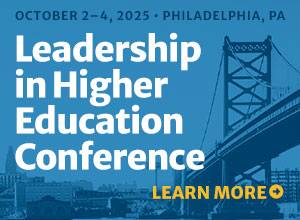A recent Inside Higher Ed article discussed the need for leadership training for faculty and academic staff as a way to prepare them for higher education’s ongoing challenges, such as competition for students, equity issues, and financial pressures (Cano & Whitfield, 2019). As faculty members in the Touro College and University System Graduate School of Education, we identified this need and in the fall of 2017 proposed an innovative faculty development project: the Touro College Academy of Leadership and Management (TCALM).
Getting started
To support the professional growth of faculty and address a growing and changing institution’s need to prepare future leaders, we presented our idea to the provost and vice presidents of the graduate and undergraduate schools. The proposal provided an overview of the program and identified application eligibility criteria (three years’ employment at the college, an essay establishing the applicant’s purpose for applying, and the recommendation and approval of the applicant’s immediate supervisor) and described the competitive selection process. The faculty who proposed the initiative agreed to develop the program and lead it from concept to inception.
After the provost and vice presidents provided feedback, we made revisions. The proposal was presented to the president and approved as a pilot for Touro College New York. The Office of the Provost financially supports this low-budget program. The funds are used to provide an initial, interactive team-building activity at an external facility; targeted academic resources (e.g., books, case studies); occasional outside speakers; and meals during the full-day events.
Program goals
Central to TCALM is the idea that individual growth requires each participant to first examine their capacity to lead. The program then supports the continuing development of the individual’s leadership mindset while focusing on leadership skills, competencies, and theory in practice. The content of the sessions would help develop the leadership skills and capabilities needed to address the challenges facing higher education and this institution. In addition, recognizing that the institution is large, complex, geographically spread out, and changing, the program designers knew that most applicants had knowledge of their own schools or departments but did not necessarily know the full scope of the organization. Consequently, a major part of the program was to fully immerse the participants in understanding the institution and its place within the local, national, and global higher education communities.
TCALM structure
Nine day-long meetings held over a period of 12 months centered on best practices in leadership development, including the following:
- Defining the environment: vision and strategy
- Collaboration and team-building skills
- Time management and managing multiple demands
- Managing up and across the organization and political savvy
- Motivating, developing, and rewarding faculty
- Resource development: human and financial
- Equity and ethical and culturally responsive leadership
- Delivering results: enrollment growth and new program initiatives
- Telling one’s story and external messaging
In deciding the size of the cohort, the program developers considered their ability to manage the process and keep costs low. The objective was to select a diverse group of faculty reflective of the various schools and programs within the college. Twelve members were chosen from the applicant pool.
It was essential that the sessions be highly interactive and provide an opportunity for the participants to examine issues, solve problems, develop communication skills, and collaborate on a variety of leadership challenges. Case studies relevant to the session topics were used to generate thought and participation. At each session, furthermore, internal and external guest speakers spoke about their experiences as leaders in higher education and presented cases from their own work for the group to discuss.
Collaborative action research was a significant part of the program. The cohort was purposefully grouped into teams to reflect the diversity of professional backgrounds and experiences. The teams were tasked with using institutional data to identify a gap in a program, department, or school or in the college. They then recommended a solution grounded in evidence and research. The proposals were presented to the college president for consideration. Ultimately, each proposal in the first cohort received approval, and now, one year later, all are being implemented as pilots.
Program assessment
Open discussions and anonymous surveys after each session allowed for participant feedback. Participants made meaningful suggestions, several of which have been implemented in the second year. The cohort members and by the college’s executive leaders found the initiative to be successful, and it and continues to receive institutional support.
Benefits to the participants and to the college
Preliminary indications point to success as evidenced by participants who have attributed promotions, in part, to participation in TCALM. Additionally, some have stated that they have gained confidence, greater networking opportunities, and a better understanding of the organization. Word of mouth from the “graduates” resulted in a strong applicant pool for the second cohort.
All three of the projects the first cohort proposed (two were related and have been merged for efficiency of effort) are moving forward and have the potential to improve services to staff and students and the functioning of the college. The program is currently being formally assessed to determine whether the original goals were met.
We believe that TCALM has proven successful. The initiative has focused on the importance of empowering faculty to propose ideas and be acknowledged by the institution’s senior leadership. It has helped the college to identify future leaders as well as address succession planning and faculty retention.
This article first appeared in Academic Leader on March 2, 2020 © Magna Publications. All rights reserved.
Reference
Cano, A., & Whitfield, K. E. (2019, November 22). Needed: Leadership training for faculty and academic staff. Inside Higher Ed. Retrieved from https://www.insidehighered.com/advice/2019/11/22/importance-cultivating-leadership-skills-among-faculty-and-academic-staff-members



